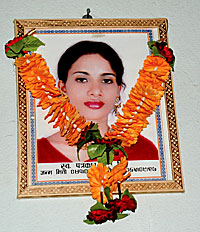 |
Janakpur's seven FM stations all have programs in Maithili language which is spoken on both sides of the border. Since there is no radio in Maithili in Bihar, Nepal's FMs have 30 million listeners in India. This is much bigger than the Maithili listenership within Nepal of only 2.5 million.
"Nepal's biggest export to India is our FM broadcast," says Gopal Jha of Janakpur's Mithila FM which has strong Maithili content designed for listeners in both India and Nepal. "This is a model for using radio to foster cultural links between South Asian countries."
Similar radio sharing could be planned between Sri Lanka and Tamil Nadu in Tamil, India and Pakistan in Kashmir and West Bengal and Bangladesh in Bengali. Says Upendra Bhagat Nayabansi of the Maithili daily, Simanchal: "We have helped the revival of Maithili culture in India as well."
The growing popularity of Nepal's Maithili FM radios in India has also made Janakpur's radio stations economically viable. Last week's Indian elections brought stations here an estimated Rs 2.5 million windfall in political commercials for Janakpur's FMs as candidates campaigned in northern Bihar constituencies. Some, like Indian state minister Shakhil Ahmed, even made sure he was interviewed on Janakpur's FM stations.
"If we had to depend on only the Nepali market, I don't think Janakpur could sustain more than two FMs," says Jha. Nepali FMs have also become an important source of news and information on issues relevant to both sides, such as cross border crime, Maoist activities and even notices about polio vaccination campaigns.
Janakpur's FM stations carry regular news about India and field dozens of reporters in Bihari towns like Madhubani, Darbhanga, Sitamarhi and Jayanagar. Two radio stations here also relay the BBC Hindi service which is very popular in Bihar.
Janakpur's FM stations all started within two months of the Madhes uprising in January 2007, and many here agree that they had a decisive effect on galvanising support. At times, the stations overdid it and the broadcasts were chauvinistic and ethnocentric.
But in the past year after Nepal got a Madhesi president and vice-president and the MJF held key ministries in the Maoist-led coalition there is a perceptible reduction in tension. This is also reflected in studio discussions and news on FMs: non-Madhesi reporters are back and the coverage of the recent Tharu protests, for instance, is balanced.
The brutal murder of Janakpur Today FM journalist Uma Singh in January shocked the country. Her garlanded photo hangs outside the studio from where she used to broadcast her programs (pictured). Three months on, it is clear that the motive for Uma Singh's murder was her muck-raking journalism, and that the suspects who have been detained were probably not involved.
The state has tried to muddy the waters and painted the crime as a family property dispute. Uma's sister-in-law Lalita Devi, local Maoist leader Shraban Yadav and three others have been detained. Locals believe the three known gangsters arrested were probably framed.
They say the real culprits are supporters of former Maoist minister Matrika Yadav who were involved in the murder of Uma's father and brother in 2007. Uma Singh wrote consistently about them in her columns. One suspect, Dilip Sah, is Yadav's son-in-law and is now in Patna. Another ex-Maoist involved, Umesh Yadav, has defected to Jwala Singh's militant group and is in Bihar. Most locals believe police are under political pressure not to arrest them, and want the case to just fade away.
See also: 'The wild east', #444 Dambar K. Shrestha
'Flames of truth', #434 by Kanak Mani Dixit
'Press post-mortem', #443
'Life after Uma', #444


